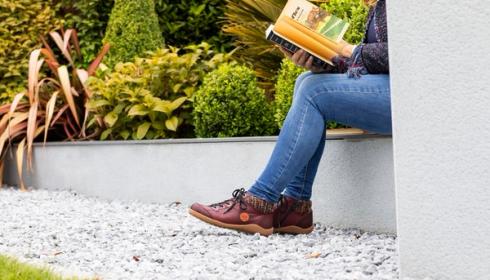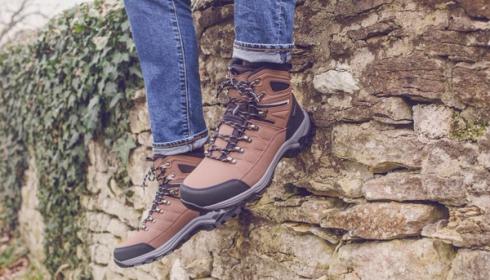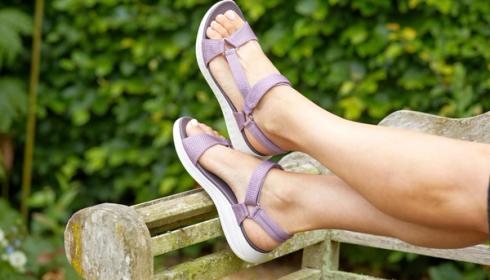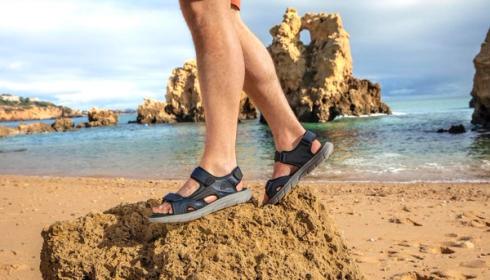
What are the Best Walking Shoes?
2 August 2023
Lace-Up and Go
Whether you're venturing on rugged trails or enjoying a leisurely stroll in the park, choosing the right shoes is key to a comfortable and enjoyable walking experience. We’ll be exploring the types of walking shoes best suited for different terrains, sharing insights on finding the perfect fit, providing handy tips on how to gently break in your shoes, as well as sharing our most popular walking sandals and walking trainers.
So, lace up, and let us guide you through your next outdoor adventure.
Shoes or Boots?
Finding the perfect footwear for your hike isn't a one-size-fits-all affair, different terrains call for different types of support and protection. If you're planning a light walk on a well-maintained path or park, walking shoes or sandals may be your go-to. They're generally lighter and offer the flexibility and comfort needed for an easy-going stroll. On the other hand, walking boots provide the added ankle support and robustness required for more challenging terrains like rocky trails and uneven landscapes. The higher ankle profile and sturdy construction of boots can make all the difference when you need that extra support. In a nutshell, walking shoes offer casual comfort, while walking boots step up to give you the protection and stability needed for those adventurous trails.
So, the next time you're planning a walk, take a moment to consider the path ahead, and pick the footwear that best suits your journey.
Ask the Expert
As we’re heading towards the autumn season, we put our in-house Quality and Technical Manager to the test, answering our most-asked questions when it comes choosing the right footwear for wet and muddy conditions.
1. What is the best material to protect feet from wet and rainy conditions?
"You can’t go wrong with a rubber shoe or wellie. Rubber is 100% waterproof, hard wearing and flexible. The only thing to consider is that it doesn’t have good insulation properties, so in snowy conditions it’s important to wear thick socks.
If you prefer a walking boot, look for one with a bellows tongue – this means that the tongue of the boot is attached higher up the boot (usually up to the third eyelet from the bottom of the tongue), and opens in a V-shape, allowing you to cross deeper water without your feet getting wet from water entering through the eyelets.
Another option is a hydrophobic (waterproof) leather boot. This is leather which has undergone special treatment during the tanning process, which allows it to repel water. A feature to add to this would be a fully bagged lining. The lining of the boot is made from a waterproof membrane (like Goretex), with stitched seams, taped to stop water from getting in. Even if the upper gets drenched your feet should still stay dry."
Try our walking boots for men with reinforced heel and toe counters and an ergonomic sole, consider these boots an investment in adventure.

2. What sort of tread should we look out for when buying walking boots?
"Ideally, you’ll need a shoe or boot with a deep tread. The key here is to look for a cross or v shape lug pattern on the sole. These lugs provide the grip needed in muddy conditions. Away from muddy conditions, the sole will still reduce slipping, as the lug pattern will push the water from underneath. This lessens your chances of slipping or aquaplaning."
3. And finally… do you have any advice on shoe care, after a long muddy walk?
"I would recommend letting your muddy shoes or boots dry fully in natural conditions, without artificial heat sources. Avoid leaving your shoes near radiators or other heat sources, as this can lead to damage to the uppers from the heat, or in extreme cases separation of the upper to the sole.
If your shoes are wet on the inside, stuff them with tissue paper or newspaper to absorb the water. Once your shoes or boots have dried naturally, brush them off afterwards."
How to Break in Walking Shoes?
Ever felt a pinch from a new pair of walking shoes? That's a tell-tale sign they need breaking in. New shoes often come with firmer materials that need to mould to the unique shape of your feet. Breaking in your walking shoes ensures that they'll provide the comfort and support you need, without unexpected blisters or discomfort.
Breaking in your new walking shoes can be a simple process. Start by wearing them around the house for short periods, allowing the material to gently stretch. Gradually increase the wear time, perhaps venturing out on shorter walks. If they feel a tad tight, wearing thicker socks can help stretch them just that little bit more. Some folks even find a shoe stretcher handy.
Remember, patience is key! Allow a week or two of gentle wear for your walking shoes to really become your own. Rushing this process might lead to sore feet and take the joy out of your walks. Take it easy, what’s the rush? Let those shoes adapt to you, and soon enough, you’ll have yourself a pair of well-fitting boots that have moulded to your feet.
Things to Consider
What distance will I be walking?
Going for a long trek or just a casual stroll? The distance you plan to walk can make a world of difference in the shoes you'll need. For those longer walks, you'll want something with excellent cushioning and support to keep you comfortable mile after mile. If it's just a jaunt around town, something lighter and more flexible might be the ticket. Either way, we're here to help you find the perfect pair to suit your journey.
What conditions will I be walking in?
Sunshine or showers, rocky paths or smooth pavements, your walking shoes need to match the conditions. Wet and muddy trails call for waterproof and grippy soles, while hot and dry conditions might require breathable materials or maybe even a pair of walking sandals. Think about where you'll be most often and let that guide your choice.
What will I be carrying?
Carrying a heavy backpack or just a bottle of water? What you have on your back can affect what you need on your feet! A heavy load may require more support and stability in your shoes, especially around the ankle. If you're travelling light, you can probably go with something less robust. It's all about finding that balance of comfort and support that fits your adventure. Pop into one of our store, and we'll help you find the right fit for your journey, no matter what you're toting along.
Our Top Tips for Choosing Walking Shoes
- Whether you're strolling around the park or hitting the hiking trails, your shoes should fit like a dream. Look for cushioning that supports your arch and a roomy toe box to avoid pinching. Trust us, your feet will thank you later.
- Looking for a pair of walking shoes that'll stand the test of time? Pay attention to the quality of the materials and construction. Look for sturdy leather or synthetic materials, reinforced stitching, and solid soles.
- The sole of your walking shoe is your foundation, so make sure it's strong. Look for a sole with good traction and grip to keep you steady on all sorts of surfaces. A rubber sole with deep grooves can be particularly effective. It’s important to feel the flexibility too; a sole that gives a bit can make your walks even more enjoyable.
- Heavy or light? It's all about finding the balance! Heavy boots may provide more support, especially on rough terrain, but they can tire you out. Lighter boots can be more comfortable and agile. Consider where you'll be walking most often and find a weight that suits your needs. Trying them on and giving them a little walk-around in the shop can help you find just the right fit.
- Look for the right support. Support in your walking shoes is all about keeping you stable and comfortable. If you’re on uneven terrain, look for shoes with ankle support, and consider the arch support that matches your foot type. A supportive shoe will hold your foot firmly but comfortably, without restricting movement. It's all about feeling confident and secure with every step, so take your time to find the perfect pair.
Get Exploring
There's a whole world out there waiting to be explored, and the right pair of walking shoes can make all the difference. From the terrain to the distance, to the weather conditions, your perfect pair is out there, and we're here to help you find it.
Ready to take the next step? Don't forget to check out our blog on the best walking trainers, tailored to every kind of adventurer. Happy walking!





